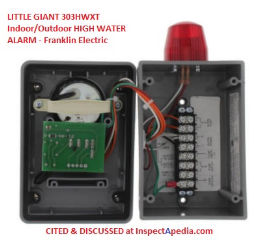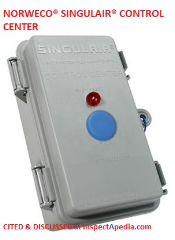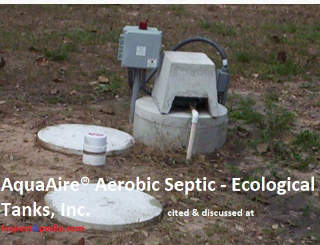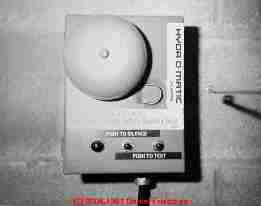 Aerobic Septic System Alarm
Aerobic Septic System Alarm
Alarm light or tone troubleshooting & repair
- POST a QUESTION or COMMENT about problems with the operation of aerobic septic systems
Aerobic septic system alarmn installation, alarm codes, & alarm problem diagnosis:
How to fix an aerobic septic system alarm that won't shut off. Checklist for aerobic septic alarm diagnosis & repair.
This article series discusses problems that occur in aerobic septic systems, also known as aeration septic systems or fine-bubble septic aerators.
InspectAPedia tolerates no conflicts of interest. We have no relationship with advertisers, products, or services discussed at this website.
- Daniel Friedman, Publisher/Editor/Author - See WHO ARE WE?
Aerobic Treatment Unit Alarms
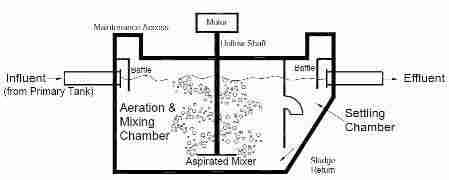 Turn off the Aerobic Septic Alarm
Turn off the Aerobic Septic Alarm
Aerobic (and other) septic alarms sound to warn of an operating problem with the system that could risk a sewage backup into the building.
If your aerobic septic alarm is visual-only you will see a flashing or solid-on red light on the alarm box or cover over your septic system or pump.
Yellow light septic alarm: aeration problem.
Red light septic alarm: high water in the septic tank = HWA - high water alarm. Turn off water, turn off the alarm, call your septic contractor. (Below we give a few things to check first.)
Audible septic alarm: buzz, shriek or whistle: go look at the alarm lights. Don't panic.
If your alarm provides a bell or buzz you will, of course, hear it. On the control panel there is usually a COMP switch that yoyu can set to "mute" to stop the alarm sound. More diagnostic and repair steps are given below in enough detail that you may be able to fix the aerobic system trouble yourself.
If there's no COMP switch, look for a lit-up button or red "off" button on the alarm box. This switch will stop the alarm from sounding.
On most septic alarm systems the warning light will remain illuminated until the pump problem has been repaired.
Audible septic alarms are usually installed in a building to alert occupants because the red-light alarm at the septic system may not be readily visible.
Every septic maintenance company, manual, and guide we reviewed says don't panic when your septic alarm sounds - it's usually not an emergency.
Should You Wait Before Calling your Septic Company for Repair?
Some septic repair companies have suggested that you should
- turn off the alarm,
- turn off any water runnning into the tank and let the efflent level in the tank drop, then turn the alarm back on
- let your aerobic effluent-dispersal spray system cycle through its sequence once or twice.
This may make sense if your aerobic spray system has not run for a time AND if your water usage was unsually high - for example during an event at which you had many visitors using the baths or toilets in your home.
Watch out: if your drains are slow, gurgling, or backing up repair is more urgent as you do not want a sewage backup into the home.
As a temporary, emergency measure, if your building's sewer line includes an outside cleanout access port, opening that port can permit sewage to spill onto the lawn rather than backing up into the building.
While it is never proper nor code-legal to discharge sewage to the surface, in an emergency, to protect a buiding, that's a defensible step. In that case you certainly need to call for emergendy repair.
See CLOGGED DRAIN DIAGNOSIS & REPAIR for help with slow drains.
You might also want to see SEPTIC BACKUP PREVENTION.
If your drains have already backed up and spilled sewage in the building
see SEWAGE BACKUP, WHAT TO DO.
In any event unless you find something trivial, I would call your septic maintenance company to schedule a service call, even if it's not an emergency.
Aerobic components to check in response to an alarm or red light
 Illustration: Alderon's Versa'larm™ I/O that can be used to monitor aerobic septic system effluluent levels & pump operation. Below we give information about this pump and include company contact information.
Illustration: Alderon's Versa'larm™ I/O that can be used to monitor aerobic septic system effluluent levels & pump operation. Below we give information about this pump and include company contact information.
[Click to enlarge any image]
Let's start with the brand and model of your aerobic system - if we know that we can find, if you don't already have one, the owners' manual that will de-code warning lights on the system.
A standard list of aerobic components to check in response to an alarm or red light includes some of the items you've already confirmed, and includes some items or features that may not be present on your aerobic septic system (that's why we need to know what system is installed).
Typicallly an aerobic septic system includes several major components & controls that you will need to check, including an air compressor for the aerator, an effluent pump for effluent disposal, and the controls that operate those pumps.
You'll also check for kinked, leaking, or crimped tubing or piping, and for effluent treatment equipment or its screens or filters that are not working or are clogged.
Homeowner Steps for Aerobic Alarm Diagnosis
Watch out: do not attempt to open, lean over, or enter a septic tank or effluent treatment chamber unless you are trained and equipped to do so. You can be overcome by methane gas and septic fumes; falling into a septic tank is often fatal.
Typically aerobic septic service companies consider only two steps safe for a homeowner to perform:
- Check that the system has electrical power
- Check that the chlorinator is not blocked
Here are diagnostic steps that are usually followed by an aerobic septic service company:
Aerobic Service Company Typical Septic Alarm Checklist
- Check the air compressor or air pump that supplies pressurized air to the aerator: check that the air pump has electrical power and is running. You'll feel it buzzing or vibrating and you might hear it.
Check for tripped circuit breakers, look for disconnected wires.
Watch out: as reader David reported in 2014, the aerator pump may be running but not actually pumping air. His pump had a bad diaphraghm. Other pump damage such as a damaged or broken impeller or worn bearings can also cause inadequate air pressure in the system. - Check the air pressure sensing tube that tells the alarm that the system has air pressure: be sure that the tube is not kinked, clogged, blocked
- Check the air line between the air compressor and the tank aerator to be sure the line is intact, connected, not kinked, not leaking (air bubbles coming out of a hole or crack int he tubing).
- Check for a clogged diffuser in the septic tank. A clogged diffuser can block air flow and clog the whole system.
- Check the level of wastewater in the septic treatment tank: is wastewater above high water level line - that will set off a high septic waste alarm.
If there is high water in the effluent tank check the next items: - Check the effluent sprinkler pump control float. Rising wastewater should lift the float that in turn operates a switch that turns on the pump.
If the float is stuck by debris, obstructions or anything in the pumping chamber the sewage grinder pump cannot turn on and off as it should. - Check the aerobic septic effluent / sprinkler pump timer or photocell to be sure that these are working to turn on the sprinkler pump
- Check the sprinkler pump: If your aerobic system uses sprinklers to distribute effluent, confirm that the sprinkler pump has electrical power and is working. As we noted for the air pump, a clog, damaged impeller, failed bearing, or a failed pump control can leave the pump not working at all or not pumping adequately.
If the sprinkler pump runs but the effluent distribution sprinklers are not working when they should, then continue to check these items: - Check the pump for a clogged inlet screen protecting the effluent pump
- Check for a clogged chlorinator treatment system for the septic effluent
- Check for clogged aerobic sprinkler spray heads not passing effluent. A spray head may be jammed or broken entirely or it may be debris clogged. A filter or screen at the inlet or base of sprinklers can become clogged and may simply need cleaning or replacement.
- Check for broken or clogged effluent distribution piping between the effluent pump and the aerobic effluent sprinkler - spray heads
For sewage pumps and septic effluluent pump alarms on other types of septic systems
Septic Alarm Sources & Aerobic Septic Alarm Instructions
Our video demonstrates the operation of a septic tank pump system alarm.
InspectAPedia is an independent publisher of building, environmental, and forensic inspection, diagnosis, and repair information provided free to the public - we have no business nor financial connection with any manufacturer or service provider discussed at our website. We do not sell products nor services.
Watch out: As with all electrical equipment these septic system controllers and alarms must be installed by a qualified technician and in accordance with model and local electrical and plumbing codes. Failure to properly install and ground electrical equipment risks shock, fire, injury or death.
- AEROBIC SEPTIC SYSTEM ATU SUPPLIERS & MANUALS - complete list of ATU suppliers & manuals
- Aero-Stream, septic tank alarm kits, Aero-Stream®, LLC
W300N7706 Christine Lane
Hartland, WI 53029
USA Tel: (877) 254-7093 TOLL FREE
(262) 538-4000 Email: info@aero-stream.com, Website: https://www.aero-stream.com/pasc.html
Excerpts:
The Septic Tank Alarm Kit integrates into Aero-Stream®’s Remediator® and Pro Line™ systems and alerts owner when the Remediator® or Pro Line™ Aerobic Generator requires a tune-up or there is an issue with the air line or diffuser.
The Septic Tank Alarm Kit – high water alerts the owner when a high water condition exists in the septic tank before a backup occurs in the dwelling, such as when an effluent pump fails or a filter needs servicing. - Alderon I/O Versa'Larm™ INSTRUCTIONS [PDF] used to monitor effluent pumping chamber, holding tank, sump pump basin,water tank, or septic tank. Retrieved 2018/03/13 original source http://www.alderonind.com/products/7004.html
Alderon Industries, Inc. P.O. Box 827 151 16th St S Hawley, MN 56549 USA, Tel: 218-483-3034 Website: http://www.alderonind.com/
Excerpt:
The Versa’larm I/O is powered by 120 VAC, “hard wired”. When a float switch “closes” the buzzer and beacon will turn “on”. Pressing the “Silence” button deactivates the buzzer and when the alarm is remedied, the system automatically resets itself. The system can be tested be pressing the “Test” switch, when pressing the switch, the buzzer should annunciate and the beacon should illuminate.
Alderon provides flood detection systems, float switches, liquid level alarms, and pump control panels. - Alderon Versalarm™ 4X INSTRUCTIONS [PDF], retrieved 2018/03/13, original source: http://www.alderonind.com/products/7035.html
Excerpt:
The Versa’larm 4X is powered by 120 VAC, “hard wired”. When power is applied, the green “Power” indicator light (located externally) will illuminate. When a float switch “closes” the buzzer and beacon will turn “on”.
Pressing the “Silence” button deactivates the buzzer and the optional auxiliary contacts. When the alarm is remedied, the system automatically resets itself.
The system can be tested be pressing the “Test” switch, when pressing the switch, the buzzer should annunciate and the beacon should illuminate. The auxiliary contacts are activated when an alarm condition occurs. The single pole double throw contacts can switch a maximum of 5 amps at 120 VAC. - Alderon Versa'larm™ INSTRUCTIONS [PDF],
retrieved 2018/03/13, original source: http://www.alderonind.com/content/2016/ii/Versalarm1ZoneInstallationInstructionsWeb.pdf
Excerpt:
A standard Versa’larm™ - Tank Alarm includes an alarm panel and a Unimax™ mechanical control switch. Receive immediate notification of threatening water levels by connecting an Auto Dialer to the Versa’larm - AquaAire 500-SERIES AEROBIC SEPTIC SYSTEM MANUAL [PDF] Ecological Tanks, Inc. - Manufacturers of Wastewater Treatment Systems
2247 Hwy 151 North, Downsville, LA 71234 USA
Tel: (318) 644-0397 Website: https://etiaquasafe.com/ retrieved 2020/01/25 original source: https://etiaquasafe.com/wp-content/uploads/sites/28/2019/02/AS500-1500_Series_OwnersManual.pdf?x48794
Excerpt:
If an [Aqua Aire aerobic septic system] alarm condition is observed, it is an indication of malfunction.
First check the electrical circuit providing power to the system to insure the circuit is closed.
Check the aerator compressor to be sure it is operating.
Check for over heating, excessive vibrations and unusual noises.
If an aerator compressor failure is observed, call your service provider for service.
After a power outage, an alarm condition may exist. Should an alarm remain on for more than thirty (30) minutes after power is restored, you should call your local service provider to report the alarm. - Australia DHA, AEROBIC WASTEWATER TREATMENT MAINTENANCE MANUAL [PDF], Department for Health and Ageing,
Government of South Australia. Retrieved 2018/03/13, original source: https://yorke.sa.gov.au/content/uploads/Maintenance-of-Aerobic-Wastewater-Treatment-Systems.pdf
Excerpt:
All aerobic wastewater treatment systems must be provided with an alarm system to alert occupants to an electrical or mechanical malfunction.
The alarm must have an audible and visual (indicator light) component with muting for the audible alarm. The fault indicators should be located inside the premises, preferably within the kitchen or laundry. - CLEARSTREAM AEROBIC SEPTIC SYSTEM OWNERS MANUAL [PDF] Models 500NS - 1500N Owners Manual, Parts List, Flow Diagram, Installation Instructions, Design Drawings, Specifications, Service Policy, Warranty, Clearstream Systems, retrieved 2018/03/13, original source: https://www.clearstreamsystems.com/wp-content/uploads/2017/10/N_Book.pdf
- CSI Controls, MINUTEMAN LEVEL ALERT MANUAL [PDF], CSI provides a variety of tan k alarms including a pedestal mounted plugger control panel with a high water alarm for aerobic septic systems.
CSI Controls, Tel: 1-800-363-5842, Website: www.csicontrols.com
Excerpt:
Using the Test - Silence - Normal toggle switch on the outside of the enclosure periodically test unit to make sure the unit is working properly.
The test mode will test the audible and visual alarms, the silence mode with silence the audible alarm during an alarm condition, and the normal mode allows the system to operate using the alarm and control floats.
Above: the Little Giant 303HWXT Indoor/Outdoor High Water Alarm (115V model) from Franklin Electric, cited below.
- Little Giant TANK ALERT XT 303 HWXT SEPTIC ALARM SYSTEM MANUAL [PDF] (2007) Franklin Electric, P.O. Box 12010 Oklahoma City, OK 73157-2010 Phone: 1.800.701.7894 Fax: 1.800.678.7867 www.LittleGiantPump.com
- Norweco Aerobic Septic Alarm, Control Panel, Pumps - Contact: Norwalk Wastewater Equipment Company, Inc., 220 Republic Street Norwalk, Ohio 44857-1156 USA, 419-668-4471 Fax:419-663-5440. Website: http://www.norweco.com/
- Norweco SINGULAIR® BIO-KINETIC 960 & TNT OWNERS MANUAL [PDF] retrieved 2020/05/09 original source: https://www.norweco.com/wp-content/uploads/2018/10/sing_om.pdf
- Norweco SINGULIR MCD SERVICE PRO® CONTROL CENTER QUICK START GUIDE [PDF] retrieved 2020/05/09 original source: https://www.norweco.com/wp-content/uploads/2018/10/Quick_Start_Guide.pdf
- Norweco SINGULIR TNT SERVICE PRO® CONTROL CENTER QUICK START GUIDE [PDF] retrieved 2020/05/09 original source: https://www.norweco.com/wp-content/uploads/2018/10/Quick_Start_Guide_TNT.pdf
- Oklahoma DEQ, AEROBIC SEWAGE TREATMENT SYSTEM MANUAL [PDF], Oklahoma Department of Environmental Quality, P.O. Box 1677 Oklahoma City, OK 73101-1677 USA Tel:(405) retrieved 2018/03/13, original source: http://www.deq.state.ok.us/eclsnew/Fact%20Sheets%20ECLS/System%20Fact%20Sheets/Aerobic.pdf
Excerpt:
Every aerobic treatment system must have an alarm (visible, audible, or both) that alerts the owner/operator of a system failure. This lets the homeowner know if the aerobic treatment unit or pump tank becomes too full or if there is a malfunction with the system.
The control box or alarm box should be kept in a place where the owner/operator can be easily alerted.
If an alarm is activated, call your maintenance provider or a professional. - Orenco, VeriComm CONTROL PANEL VCOM-S1-RO MANUAL [PDF], (2002) Orenco Systems Incorporated, 814 Airway Ave., Sutherlin, OR 97479-9012 USA, Tel: 541-459-4449
Installation instructions, wiring diagrams, etc. for septic system control and alarm equipment.
Excerpts:
This document contains general installation instructions for VeriComm® control panels. Consult all supplemental documents (Control Panel Wiring Diagram, Float Arrangement Diagram, etc.) before installation.
VCOMS-S RO Panel overview:
The VCOM-S RO telemetry-enabled panel is used for remote monitoring and control of ondemand simplex pumping operations. Basic control logic manages the day-to-day functionality of the control panel.
As the [septic] tank fills with effluent, floats activate a discharge pump. A pump cycle starts when the top float is raised by effluent, and ends when the middle float drops. Fault conditions are automatically reported to the VeriComm Monitoring System and not locally at the panel, making the system virtually invisible to the homeowner.
However, if fault conditions are not responded to, or the system cannot communicate with the VeriComm Monitoring System, then local alarms may be activated.
To silence local alarms, press the “Push-To- Silence” button until the audible alarm stops.
Note regarding a normal thumping sound: If the panel contains motor contactors, a thumping sound can be heard each time the pump is started or stopped. Therefore, these panels should not be mounted on an exterior wall unless it is in a location away from living areas, such as on a garage wall. - SPI 500 OBSERVER 500 INDOOR /OUTDOOR ALARM INSTRUCTIONS [PDF], SPI - Septic Products Inc, 1378 Township Road 743, Ashland OH 44805 USA, Tel: 419-282-5933, Website: http://www.septicproducts.com/
SPI provides alarms including the Observer 100 - 500 alarms, float switches, and "BIO" Aerobic septic system control panels.
For a complete list of instructions for SPI alarms and control panels see http://www.septicproducts.com/installation-instructions
...
Reader Comments, Questions & Answers About The Article Above
Below you will find questions and answers previously posted on this page at its page bottom reader comment box.
Reader Q&A - also see RECOMMENDED ARTICLES & FAQs
On 2020-05-07 0 - by (mod) - red alarm light at septic tank stays on
It may not be enough with the pump is running. Check the effluent level in the tank. If that's not dropping there's something wrong with the pumping system.
On 2020-05-07 by lafondmike634@gmail.com
I had all four tanks cleaned and a new air pump installed. Once the tanks got full the main pump comes on but the red light stays on. I can hear the air pump running.
On 2020-01-23 - by (mod) -
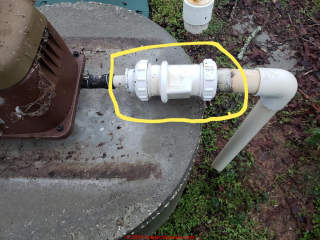 Brandi
Brandi
you posted this question and we replied in detail at
AEROBIC ATU SEPTIC PROBLEMS
please take a look and don't hesitate to ask follow-up questions
On 2020-01-23 by brandimurray2010
This circled piece is vigorously vibrating and not secured on either end when system is on.
On 2019-10-28 - by (mod) - DId your Hoot Aerobic septic pump turn back on?
Michael
DId your Hoot Aerobic septic pump turn back on? Some pump systems do not run 24/7 but rather are on a timer while other designs keep the pump on all the time.
If the aerobic pump never turns on then the sensor reporting its operation is defective and it's also time to diagnose and/or replace the pump.
See details
at HOOT AEROBIC SEPTIC TROUBLESHOOTING
On 2019-10-24 by Michael
I have a hoot aerobic system. The air pump is not running but the system control panel still has a green light and says system is fine. Isn't the pump supposed to always be running and if so why no alarm?
On 2019-04-14 by (mod) - Norweco Singulair Aerobic System alarm light is flashing twice then a 3 second delay and 2 flashes
Norweco Singulair Aerobic System alarm light is flashing twice then a 3 second delay and 2 flashes.
From what I can find this indicates a problem with the motor.
I bought a new motor and installed it and still getting the same alarm. What could be the issue?
This question and reply were originally posted at AEROBIC ATU SEPTIC PROBLEM FAQs
Illustration: Norweco's Service Pro® Control Center used iwth Singulair® septic systems.
Anon said:
Chris:
Check for an outlet blockage.
Moderator said:
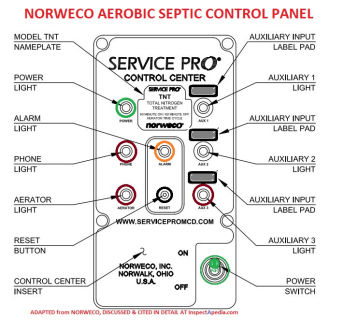 For an open motor or under current condition, the
alarm on a Norweco Singular control center will display two short flashes followed by a pause.
For an open motor or under current condition, the
alarm on a Norweco Singular control center will display two short flashes followed by a pause.
I'm not sure about the 2-3 flash you describe.
You don't describe which septic and control models you have from Norweco except for the Norweco Singulair alarm.
If you have the MCD or TNT model of Norweco Singular system see the appropriate "Quick Start Guide" below for help in responding to an alarm. Else contact Norweco at the location I'll give below.
Here are some Norwco septic system manuals that may help you.
- Norweco SINGULAIR® BIO-KINETIC 960 & TNT OWNERS MANUAL [PDF] Norweco 220 Republic St., Norwalk, OH 44857-1156 USA, Tel (419) 668-4471 Fax (419) 663-5440 Website: www.norweco.com retrieved 2020/05/09 original source: https://www.norweco.com/wp-content/uploads/2018/10/sing_om.pdf
- Norweco SINGULIR MCD SERVICE PRO® CONTROL CENTER QUICK START GUIDE [PDF] retrieved 2020/05/09 original source: https://www.norweco.com/wp-content/uploads/2018/10/Quick_Start_Guide.pdf
Excerpt: The Service Pro control center combines integrated circuitry, advanced telemetry and web-based data acquisition for the remote management of any wastewater treatment system.
Service Pro is the only control center that employs the revolutionary Monitoring, Compliance and Diagnostic (MCD) Technology.
Designed to automatically operate the Singulair treatment plant, Service Pro also monitors the operation of the entire onsite system and provides verification of compliance with installation permit requirements.
Service Pro MCD control centers are equipped with on-board diagnostics that verify when service work is performed and when maintenance is required. - Norweco SINGULIR TNT SERVICE PRO® CONTROL CENTER QUICK START GUIDE [PDF] retrieved 2020/05/09 original source: https://www.norweco.com/wp-content/uploads/2018/10/Quick_Start_Guide_TNT.pdf
- Noreweco SERVICE PRO® CONTROL CENTER SPECIFICATIONS [PDF] retrieved 2020/05/09 original source: https://www.norweco.com/wp-content/uploads/2018/10/Service-Pro-Specifications.pdf
Excerpt: The Service Pro control center shall monitor the operation of the Singulair system and up to three auxiliary treatment components. The performance of the Singulair aerator shall be constantly monitored to detect any aerator over current, aerator under current or open motor condition.
If any one of these conditions is detected, power to the aerator shall be interrupted, a diagnostic sequence shall begin and the visual alarm shall activate. After a factory programmed recovery interval, an automatic restart attempt shall be initiated.
If normal aerator operation does not resume during 24 programmed recovery and restart cycles, the audible alarm shall activate and, if the telemetry system has been enabled, the control center shall report the specific condition to the Service Pro monitoring center.
In the event that any of the auxiliary inputs detect an operational problem, the audible and visual alarms shall immediately activate and, if the telemetry system has been enabled, the control center shall report the specific alarm condition to the monitoring center.
The distributor shall be automatically notified by the Service Pro monitoring center of the specific alarm condition using phone, fax or email.
- Norweco SINGULAIR SERVICE-PRO CONTROL CENTER Brochure [PDF] retrieved 2020/05/09 original source: https://www.norweco.com/wp-content/uploads/2018/10/SVC_PRO_BROCHURE.pdf
Give Norweco a call.
Norweco
220 REPUBLIC STREET
NORWALK, OHIO, USA 44857-1156
TELEPHONE (419) 668-4471
FAX (419) 663-5440
www.norweco.com
Question: Enbironment One Aqua Safe® aerobic alarm sounding
Thank God you are here!
We have an Aqua safe system. Had it cleaned out yesterday and now our aqua safe alarm is going off.
I was told this is normal and should go off in a few days
. I have been trying to research this. could this be due to lack of liquid in the tank causing low pressure? Do we need to fill it with water?
This has never happened before.
Photo of an Aqua-Aire aerobic septic system as installed, showing the control box location. Photo courtesy of AquaAire cited above.
This Q&A were posted originally
at AEROBIC ATU SEPTIC PROBLEM FAQs
Reply:
Joyce
First let's silence the alarm; there should be a switch or button on the control box that will do that. (Post a photo of your control box and I may be able to comment further).
An septic alarm might sound for up to 30 minutes after power has been off to the system, but if the alarm is sounding longer than that more action is needed.
If you don't have an owners's manual for your AquaSafe aerobic system, you might give a call to
Ecological Tanks, Inc. - Manufacturers of Wastewater Treatment Systems 2247 Hwy 151 North, Downsville, LA 71234 USA
Tel: (318) 644-0397 (Mon-Fri 8AM - 5 PM) though you can also contact the company by email aquasafe@bayou.com
But you shouldn't need to fill your system with water; normal use of plumbing in the home should be all that's needed.
I rather suspect there's a stuck control or float or a leak in the air pump system.
On your AquaSafe the two causes of an alarm to sound are HIGH water (that would mean a pump isn't working) or an aerator pump failure - check that your aerator pump is running.
The company says
" If an alarm condition is observed, it is an indication of malfunction.
First check the electrical circuit providing power to the system to insure the circuit is closed.
Check the aerator compressor to be sure it is operating.
Check for over heating, excessive vibrations and unusual noises.
If an aerator compressor failure is observed, call your service provider for service.
After a power outage, an alarm condition may exist. Should an alarm remain on for more than thirty (30) minutes after power is restored, you should call your local service provider to report the alarm."
I'm looking for more information to see what I can add.
If your Aqua-Safe aerobic is in the AS-500-1500 series then you can download the owners' manual
At inspectapedia.com/septic/Aqua-Safe-AS500-1500-Owners-Manual.pdf
...
Continue reading at AEROBIC ATU SEPTIC PROBLEMS - topic home, or select a topic from the closely-related articles below, or see the complete ARTICLE INDEX.
Or see AEROBIC SEPTIC ALARM SYSTEM FAQs - questions & answers about troubleshooting alarms and warning lights on aerobic septic system controls, pumps, etc. - posted originaly on this page.
Or see these
Recommended Articles
- AEROBIC SEPTIC SYSTEMS, ATUs - home
- AEROBIC SEPTIC ALARM SYSTEMS - how to silence & troubleshoot
- AEROBIC SEPTIC FILTER CLOGGING
- AEROBIC ATU SEPTIC FAILURE RATES, COSTS
- AEROBIC SEPTIC SYSTEM ATU SUPPLIERS & MANUALS
- AEROBIC ATU SEPTIC PROBLEMS
- AEROBIC ATU SEPTIC MAINTENANCE PROCEDURES
- HOOT AEROBIC SEPTIC TROUBLESHOOTING
Suggested citation for this web page
AEROBIC SEPTIC ALARM SYSTEMS at InspectApedia.com - online encyclopedia of building & environmental inspection, testing, diagnosis, repair, & problem prevention advice.
Or see this
INDEX to RELATED ARTICLES: ARTICLE INDEX to SEPTIC SYSTEMS
Or use the SEARCH BOX found below to Ask a Question or Search InspectApedia
Ask a Question or Search InspectApedia
Questions & answers or comments about problems with the operation of aerobic septic systems
Try the search box just below, or if you prefer, post a question or comment in the Comments box below and we will respond promptly.
Search the InspectApedia website
Note: appearance of your Comment below may be delayed: if your comment contains an image, photograph, web link, or text that looks to the software as if it might be a web link, your posting will appear after it has been approved by a moderator. Apologies for the delay.
Only one image can be added per comment but you can post as many comments, and therefore images, as you like.
You will not receive a notification when a response to your question has been posted.
Please bookmark this page to make it easy for you to check back for our response.
IF above you see "Comment Form is loading comments..." then COMMENT BOX - countable.ca / bawkbox.com IS NOT WORKING.
In any case you are welcome to send an email directly to us at InspectApedia.com at editor@inspectApedia.com
We'll reply to you directly. Please help us help you by noting, in your email, the URL of the InspectApedia page where you wanted to comment.
Citations & References
In addition to any citations in the article above, a full list is available on request.
- Document Sources used for this web page include but are not limited to: Agricultural Fact Sheet #SW-161 "Septic Tank Pumping," by Paul D. Robillard and Kelli S. Martin. Penn State College of Agriculture - Cooperative Extension, edited and annotated by Dan Friedman (Thanks: to Bob Mackey for proofreading the original source material.)
- Advanced Onsite Wastewater Systems Technologies, Anish R. Jantrania, Mark A. Gross. Anish Jantrania, Ph.D., P.E., M.B.A., is a Consulting Engineer, in Mechanicsville VA, 804-550-0389 (2006). Outstanding technical reference especially on alternative septic system design alternatives. Written for designers and engineers, this book is not at all easy going for homeowners but is a text I recommend for professionals--DF.
- US EPA ONSITE WASTEWATER TREATMENT SYSTEMS MANUAL [online copy, free] Top Reference: US EPA's Design Manual for Onsite Wastewater Treatment and Disposal, 1980, available from the US EPA, the US GPO Superintendent of Documents (Pueblo CO), and from the National Small Flows Clearinghouse. Original source http://www.epa.gov/ORD/NRMRL/Pubs/625R00008/625R00008.htm Onsite wastewater treatment and disposal systems, Richard J Otis, published by the US EPA. Although it's more than 20 years old, this book remains a useful reference for septic system designers. U.S. Environmental Protection Agency, Office of Water Program Operations; Office of Research and Development, Municipal Environmental Research Laboratory; (1980)
- Eco John® Innovative Toilet Solutions, Global Inventive Industries, Fountain Valley CA, PDF, product brochure
- "International Private Sewage Disposal Code," 1995, BOCA-708-799-2300, ICBO-310-699-0541, SBCCI 205-591-1853, available from those code associations.
- "Manual of Policy, Procedures, and Guidelines for Onsite Sewage Systems," Ontario Reg. 374/81, Part VII of the Environmental Protection Act (Canada), ISBN 0-7743-7303-2, Ministry of the Environment,135 St. Clair Ave. West, Toronto Ontario M4V 1P5 Canada $24. CDN.
- Onsite Wastewater Disposal, R. J. Perkins; Quoting from Amazon: This practical book, co-published with the National Environmental Health Association, describes the step-by-step procedures needed to avoid common pitfalls in septic system technology. Valuable in matching the septic system to the site-specific conditions, this useful book will help you install a reliable system in both suitable and difficult environments. Septic tank installers, planners, state and local regulators, civil and sanitary engineers, consulting engineers, architects, homeowners, academics, and land developers will find this publication valuable.
- Onsite Wastewater Treatment Systems, Bennette D. Burks, Mary Margaret Minnis, Hogarth House 1994 - one of the best septic system books around, suffering a bit from small fonts and a weak index. (DF volunteers to serve as indexer if Burks/Minnis re-publish this very useful volume.) While it contains some material more technical than needed by homeowners, Burks/Minnis book on onsite wastewatre treatment systems a very useful reference for both property owners and septic system designers. We refer to it often. While Minnis says the best place to buty this book is at Amazon
- The NSFC Products List has an excellent list of design manuals/modules National Small Flows Clearinghouse (NSFC) now (2019/12/13) hosted at http://www.nesc.wvu.edu/ Tel: 304-293-4191 e-mail info@mail.nesc.wvu.edu.
The National Small Flows Clearinghouse (NSFC) was funded by the U.S. Environmental Protection Agency (EPA) to help America's small communities and individuals solve their wastewater problems through objective information about onsite wastewater collection and treatment systems. NSFC products and information are the only national resource of its type, dealing with small community wastewater infrastructure. or by telephone 800-624-8301 - In addition to citations & references found in this article, see the research citations given at the end of the related articles found at our suggested
CONTINUE READING or RECOMMENDED ARTICLES.
- Carson, Dunlop & Associates Ltd., 120 Carlton Street Suite 407, Toronto ON M5A 4K2. Tel: (416) 964-9415 1-800-268-7070 Email: info@carsondunlop.com. Alan Carson is a past president of ASHI, the American Society of Home Inspectors.
Thanks to Alan Carson and Bob Dunlop, for permission for InspectAPedia to use text excerpts from The HOME REFERENCE BOOK - the Encyclopedia of Homes and to use illustrations from The ILLUSTRATED HOME .
Carson Dunlop Associates provides extensive home inspection education and report writing material. In gratitude we provide links to tsome Carson Dunlop Associates products and services.



